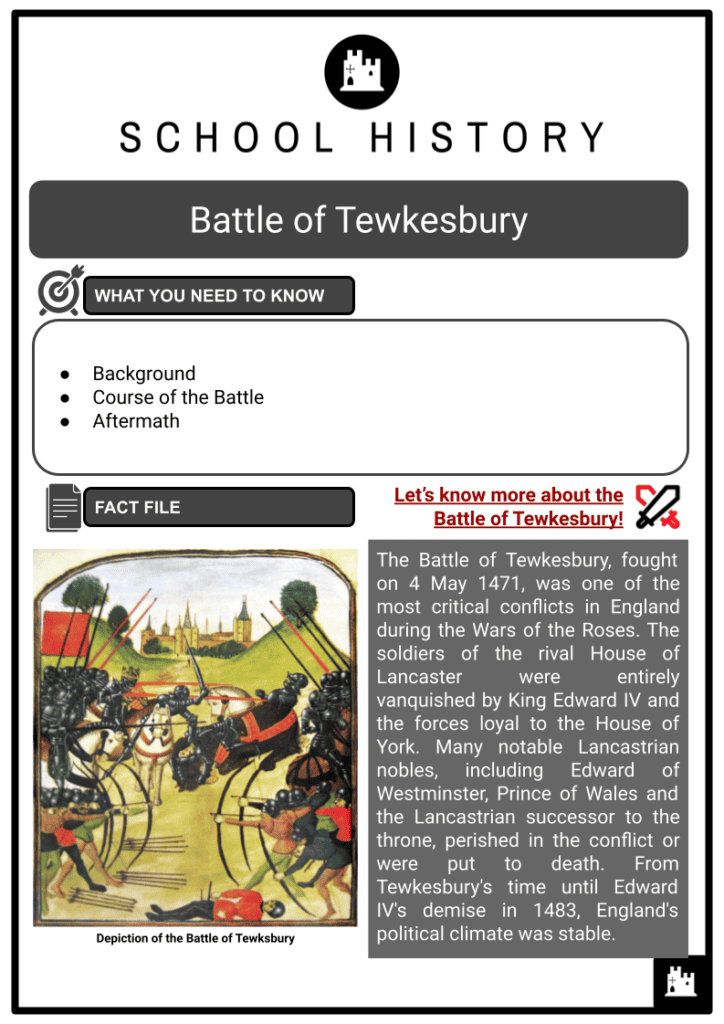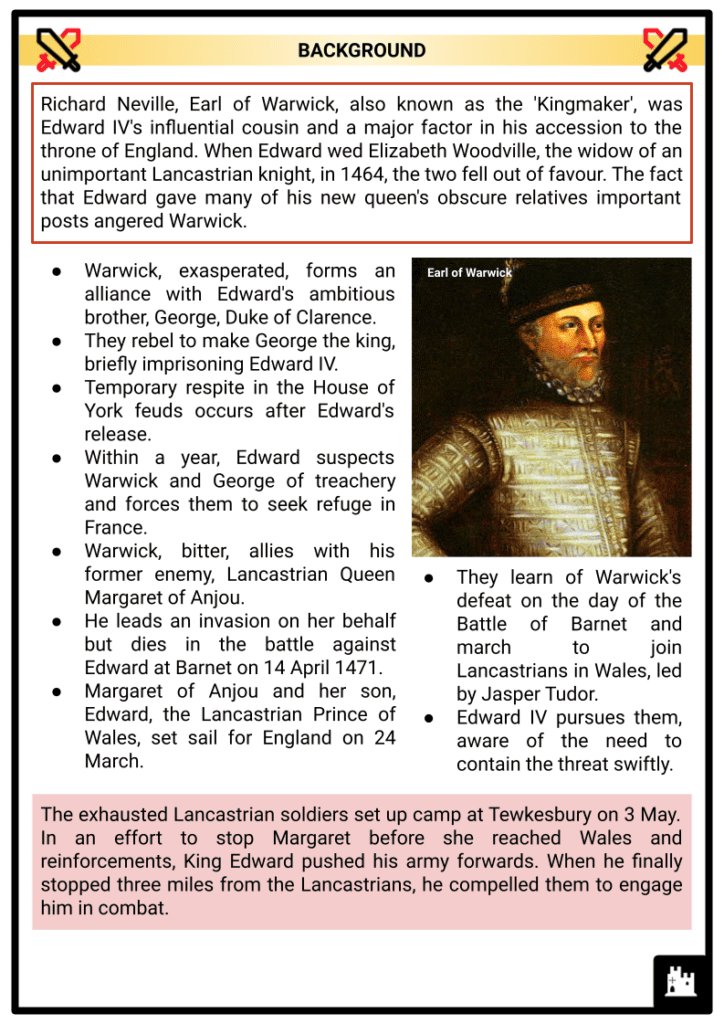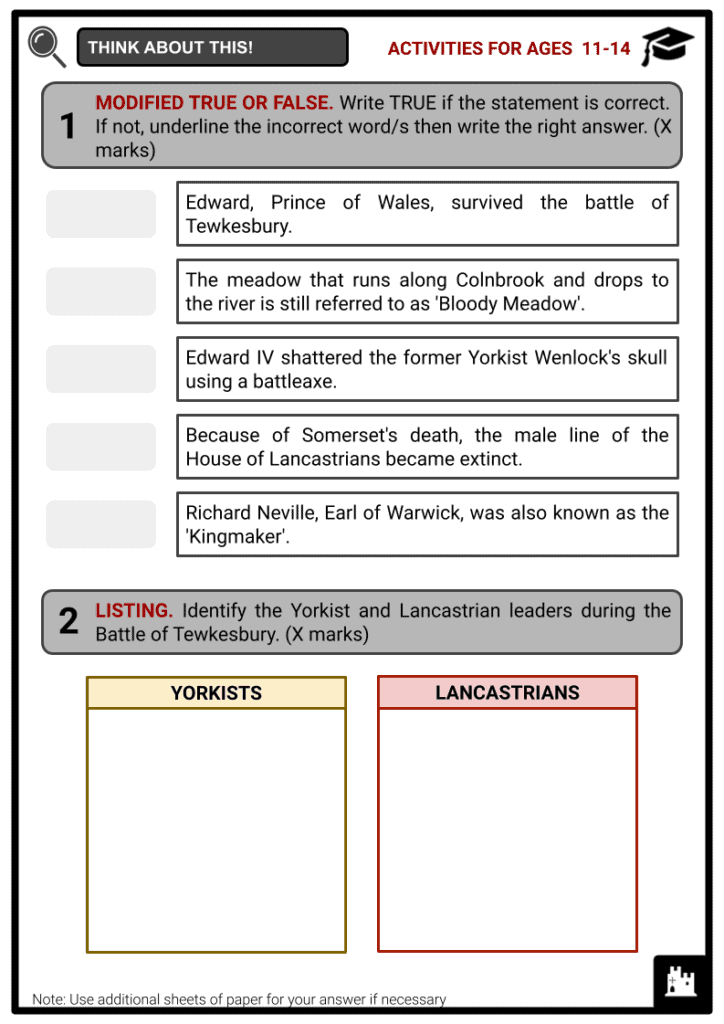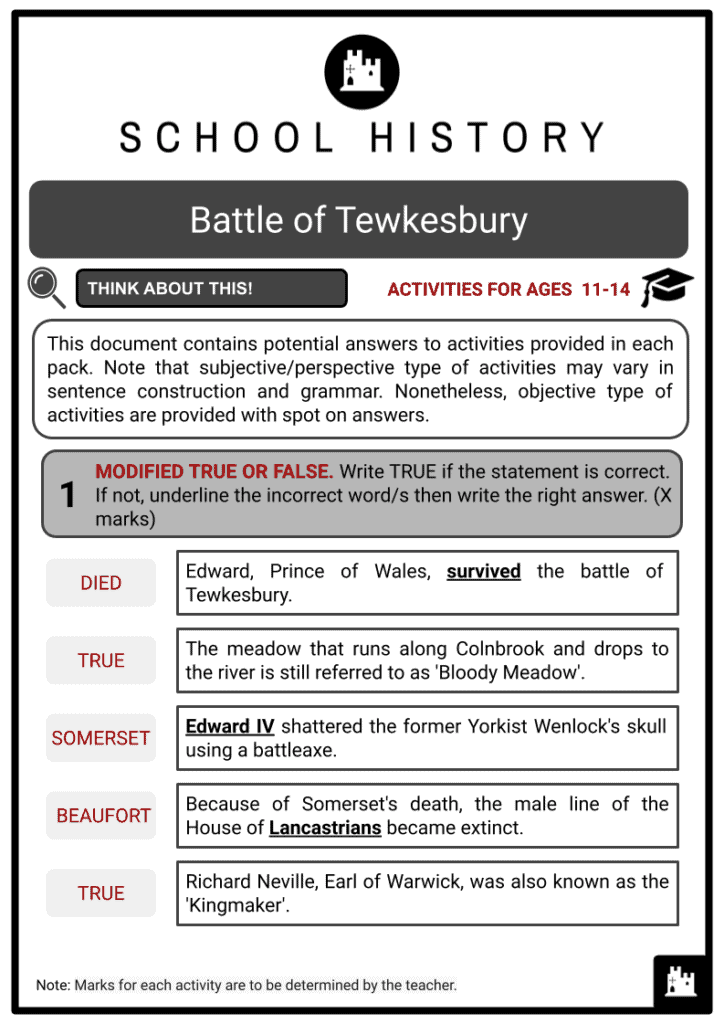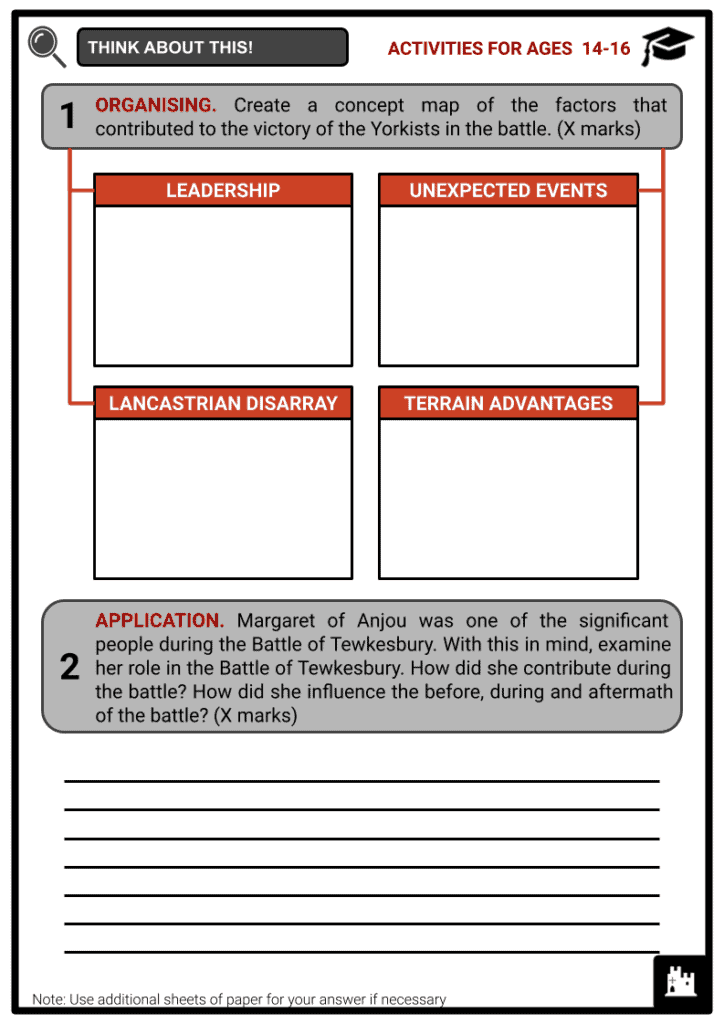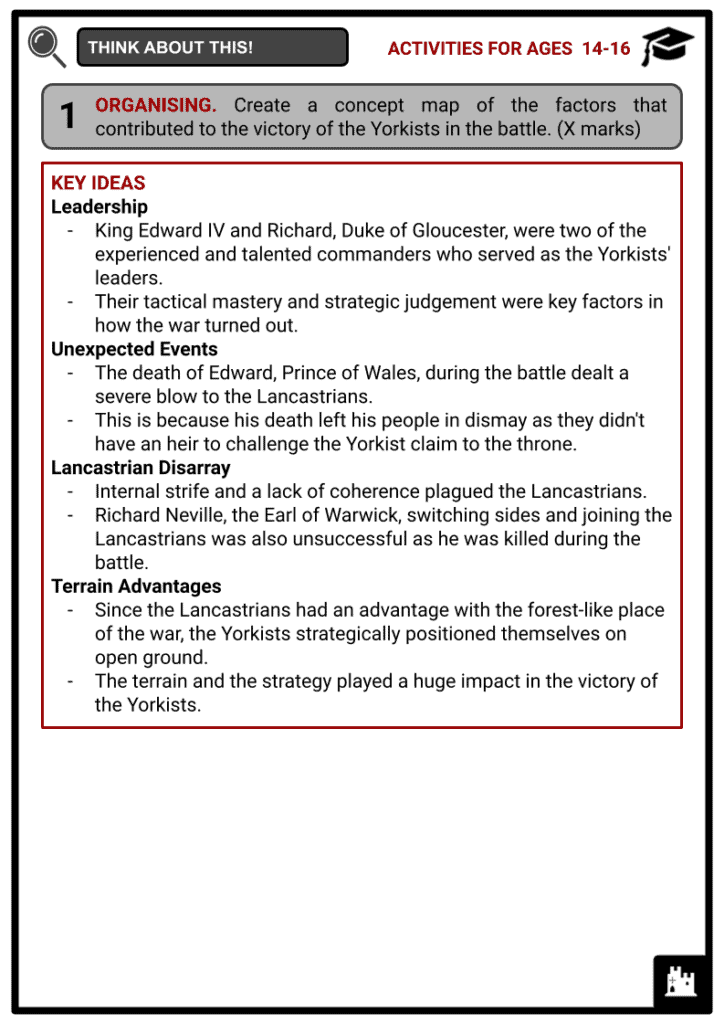Battle of Tewkesbury Worksheets
Do you want to save dozens of hours in time? Get your evenings and weekends back? Be able to teach about the Battle of Tewkesbury to your students?
Our worksheet bundle includes a fact file and printable worksheets and student activities. Perfect for both the classroom and homeschooling!
Summary
- Background
- Course of the Battle
- Aftermath
Key Facts And Information
Let’s know more about the Battle of Tewkesbury!
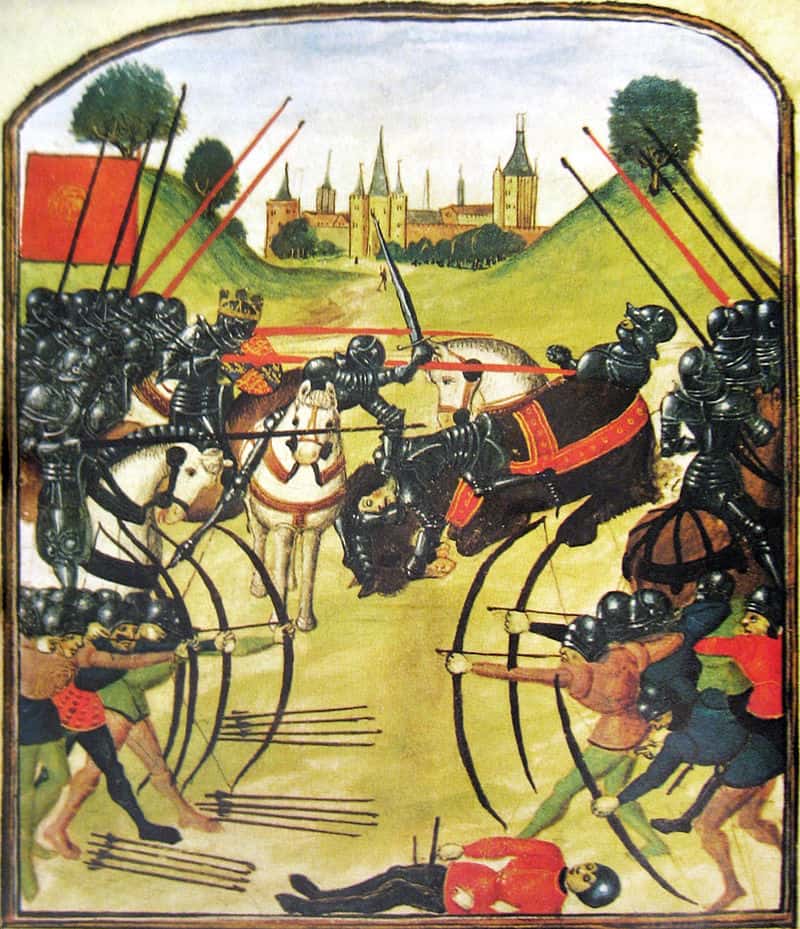
The Battle of Tewkesbury, fought on 4 May 1471, was one of the most critical conflicts in England during the Wars of the Roses. The soldiers of the rival House of Lancaster were entirely vanquished by King Edward IV and the forces loyal to the House of York. Many notable Lancastrian nobles, including Edward of Westminster, Prince of Wales and the Lancastrian successor to the throne, perished in the conflict or were put to death. From Tewkesbury's time until Edward IV's demise in 1483, England's political climate was stable.
BACKGROUND
- Richard Neville, Earl of Warwick, also known as the 'Kingmaker', was Edward IV's influential cousin and a major factor in his accession to the throne of England. When Edward wed Elizabeth Woodville, the widow of an unimportant Lancastrian knight, in 1464, the two fell out of favour. The fact that Edward gave many of his new queen's obscure relatives important posts angered Warwick.
- Warwick, exasperated, forms an alliance with Edward's ambitious brother, George, Duke of Clarence.
- They rebel to make George the king, briefly imprisoning Edward IV.
- Temporary respite in the House of York feuds occurs after Edward's release.
- Within a year, Edward suspects Warwick and George of treachery and forces them to seek refuge in France.
- Warwick, bitter, allies with his former enemy, Lancastrian Queen Margaret of Anjou.
- He leads an invasion on her behalf but dies in the battle against Edward at Barnet on 14 April 1471.
- Margaret of Anjou and her son, Edward, the Lancastrian Prince of Wales, set sail for England on 24 March.
- They learn of Warwick's defeat on the day of the Battle of Barnet and march to join Lancastrians in Wales, led by Jasper Tudor.
- Edward IV pursues them, aware of the need to contain the threat swiftly.
- The exhausted Lancastrian soldiers set up camp at Tewkesbury on 3 May. In an effort to stop Margaret before she reached Wales and reinforcements, King Edward pushed his army forwards. When he finally stopped three miles from the Lancastrians, he compelled them to engage him in combat.
COURSE OF THE BATTLE
- The Lancastrians, who were around 6,000, took up defensive positions at first light on 4 May about a mile south of Tewkesbury. The Rivers Avon and Severn were to their rear. The Lancastrian settlement was located right behind Tewkesbury Abbey.
- Queen Margaret sought safety at a church some distance from the battleground. Duke of Somerset Edmund Beaufort led the Lancastrian right. The seasoned Baron Wenlock and the 18-year-old Prince Edward led the centre. John Courtenay, Earl of Devon, a devoted Lancastrian, led the left-wing assault. In order to address the men, Prince Edward, the grandson of Henry V, rode along the Lancastrian line.
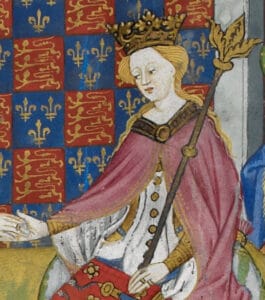
Queen Margaret - The slightly outnumbered Yorkist army, with around 5,000 men, was led by Edward IV, who kept his clever brother Clarence by his side. His youngest brother, the 18-year-old Richard, Duke of Gloucester, who would later become Richard III, led the vanguard, and Lord Hastings oversaw the rear. In a forested park to the left of the Yorkist army, Edward stationed 200 mounted spearmen.
- The Yorkists advanced towards the Lancastrian position, attacking with volleys of arrows and shots.
- The Duke of Somerset, aiming to outflank Edward, led a force to attack the Yorkists' left flank.
- The Lancastrian field was protected by hedges, trees and bushes, making it difficult for the Yorkists to approach.
- Edmund, Duke of Somerset, and his group were heavily harassed by gunfire and arrows, forcing them to move away from the main Lancastrian force.
- Somerset, displaying courage and bravery, led his fellowship towards the King's vanguard from an unexpected direction.
- He secretly left the field, passed through a lane and entered a fair place or close in front of the King's position. From a hill in one of the closes, he fiercely attacked the end of the King's battle.
- The Yorkists refused to fight back against Somerset's assault. Edward's 200 spearmen attacked Somerset from his own exposed right flank and rear. Edward had already put them up in the woods. Somerset's men made a futile attempt to cross the Severn after being routed. Most were massacred as they ran away. The name 'Bloody Meadow' is still used to refer to the meadow along the Colnbrook that descends to the river.
- The enraged Somerset went back to the Lancastrian lines, rode up to the former Yorkist Wenlock who was in charge of the centre, demanded to know why he hadn't offered support, and without waiting for a response, shattered his skull with a battleaxe in wrath. Then, Somerset went to Tewkesbury Abbey looking for safety. The Lancastrian army's morale decreased, panic set in and the remainder fled. Many of them were slain by the pursuing Yorkists or perished in the River Avon. Up to 2,000 Lancastrians may have died because no quarter was provided.
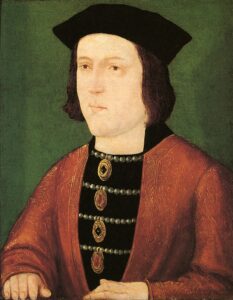
Edward IV - The last official member of the House of Lancaster, Edward, Prince of Wales, the 18-year-old son of Queen Margaret, was killed either in combat or in its aftermath.
- Prince Edward's demise is the subject of several competing stories. According to one, he was killed while fleeing north after the battle.
- According to another, after the Lancastrians were routed, a small group of men led by the Duke of Clarence found Edward near a grove. There, he was quickly decapitated on a makeshift block despite pleas for mercy to his brother-in-law Clarence.
AFTERMATH
- Two days later, after quick trials, Gloucester and the Duke of Norfolk, the Constable of England, ordered the execution of Somerset and other leaders who had been dragged from the Abbey. Hugh Courtenay, the Earl of Devon's younger brother, and Sir John Langstrother, the military order of St John's prior, were among them. A month after the fight, the Abbey had to be rededicated due to the bloodshed that had occurred there. At the Abbey, Somerset was buried alongside his younger brother John Beaufort, who had perished in the conflict. As a result, the male line of the House of Beaufort became extinct.
- From 21 to 22 May 1471, the night of the Vigil of the Ascension, Henry VI passed away in the Tower of London. He was doomed after his son died in Tewkesbury. Edward of Lancaster had made it futile to remove Henry while he was still alive. Margaret Beaufort and her son Henry Tudor served as the senior representatives of the House of Lancaster following the deaths of Henry VI and the male line of the Beaufort family.
- After Tewkesbury, Thomas Neville, the Bastard of Fauconberg (Warwick's cousin), gathers an army in Kent.
- He attempts to march on London but is refused entry by the city.
- In retaliation, he burns Southwark and plans a three-prong assault on London.
- Fauconberg's army places artillery on the south bank of the Thames and prepares to attack at Aldgate and Bishopsgate.
- A third party attempts to cross London Bridge but is beaten back.
- The attack on Bishopsgate is foiled by the Earl of Essex.
- Though they manage to open Aldgate, the city's defenders fight back, and all attempts to take London fail.
Frequently Asked Questions
- What was the Battle of Tewkesbury?
The Battle of Tewkesbury was significantly fought in May 1471, during the Wars of the Roses between the rival houses of Lancaster and York for control of the English throne.
- Who won the Tewkesbury battle?
The Battle of Tewkesbury was won by the Yorkists, led by King Edward IV. The Yorkists achieved a decisive victory over the Lancastrians, led by Margaret of Anjou and her son Edward, Prince of Wales.
- What was the outcome of the Battle of Tewkesbury?
The Yorkists emerged victorious, decisively defeating the Lancastrian forces. The Lancastrian leader, Edward, Prince of Wales was killed during the battle. This victory solidified Edward IV's control over the English throne and marked a significant turning point in the Wars of the Roses.

